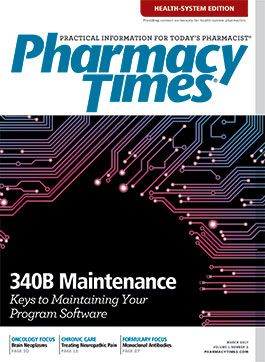Publication
Article
Pharmacy Practice in Focus: Health Systems
340B Maintenance: Keys to Maintaining Your 340B Program Software to Ensure a Compliant Program
The 340B Drug Pricing Program began in 1992 with the intent of permitting covered entities “to stretch scarce federal resources as far as possible, reaching more eligible patients and providing more comprehensive services.”
The 340B Drug Pricing Program began in 1992 with the intent of permitting covered entities “to stretch scarce federal resources as far as possible, reaching more eligible patients and providing more comprehensive services.”1 In other words, the 340B Program helps safety-net providers carry out their missions to serve their communities. Covered entities, as defined in statute, are health care organizations that must meet certain eligibility requirements to qualify for the 340B Program. Examples of covered entities are the Aids Drug Assistance Programs, Federally Qualified Health Centers (FQHCs) and FQHC lookalikes, and Disproportionate Share Hospitals (DSH).1 The program is managed by the Health Resources & Services Administration (HRSA) and supported by HRSA’s Office of Pharmacy Affairs (OPA).2 In turn, OPA provides guidance to stakeholders to promote compliance and integrity within the program.
Participation in the 340B Program allows entities to realize significant savings on covered outpatient drugs.2 Covered entities are responsible for ensuring that the realized program savings are used to increase access to services and medications for their patients3 and for ensuring that they are compliant with all of the 340B Program rules and regulations. The major program integrity focus areas are:
• 340B Program eligibility
• Accurate entity records on the 340B database
• Adherence to the Government Publishing Office Prohibition (applicable to DSH, free-standing cancer hospitals, and children’s hospitals)
• Prevention of duplicate discounts
• Prevention of diversion
• Maintain auditable records
All covered entities are required to attest to compliance for each of the statutory requirements through annual recertification.4 HRSA also has the authority to perform audits of covered entities to ensure compliance.5 As a result, many covered entities employ staff for the oversight and maintenance of their 340B Program. These employees develop and maintain 340B Program policies and procedures, perform routine monthly audits, complete business reviews and risk assessments, administer the split-billing software, and maintain the 340B database. Maintenance of the OPA 340B database for covered entities includes, but is not limited to, registering child sites (eg, eligible clinics or departments that have a different physical address from the covered entity) and contract pharmacies, accurately listing the authorizing official and primary contact, adding shipto and bill-to sites, and entering hospital national provider identifiers in the Medicaid exclusion file, if applicable.
Covered entities have the option to use split-billing software to support their goal of establishing compliant 340B operations within their respective health care organizations. This software uses filters and various settings, determined by each entity, to separate eligible 340B transactions from ineligible transactions. This allows covered entities to maximize their 340B Program, while automating the accumulation of eligible and ineligible transactions. Although the software can be very effective in helping covered entities manage their programs, it also requires consistent maintenance to ensure integrity. 340B-focused roles are typically responsible for the implementation and management of the split-billing software; however, best practice sites also use their purchasing agents for the maintenance of the software.
The online table shows examples of functions that are involved in implementation. Maintain a similar table to ensure compliant split-billing software.
TABLE: Functions Involved in Implementing and Maintaining Split-Billing Software
Type of Split-Billing Software Maintenance
Description of Maintenance
Frequency of Completion
Performed By
Configuration setting review
Review of configuration settings, such as terminating accounts, patient eligibility windows, etc, to ensure compliant practices
Quarterly
340B Program manager (or similar role)
Wholesaler invoice evaluation
Initial setup and auditing of wholesaler or direct manufacturer purchasing accounts in software via EDI
As needed
340B Program manager (or similar role)
Manual invoice transactions
Perform manual uploads of 340B, GPO, WAC invoices not EDI-capable
Daily
340B Program manager (or similar role)
Charge master (CDM) mapping
Mapping of Charge Data Masters to correct payor billing ratios and remain up-to-date with new CDMs and changes to billing units
Weekly
Purchasing agent, 340B specialist (or similar role)
NDC mapping
Mapping of purchased NDC to charge data master code
Weekly
Purchasing agent, 340B specialist, or similar role
Location mapping
Mapping ADT location codes to 340B eligibility status
Monthly
340B Program manager (or similar role)
EMR file maintenance
Ensure transmission, receipt, and processing of files from EMR to software vendor
Daily
340B specialist (or similar role)
ADT = admission, discharge, and transfer; CDM, =; EDI = electronic data interchange; EMR = electronic medical record; GPO = Government Publishing Office; NDC = National Drug Code; WAC = wholesale acquisition cost.
ALEXANDRA M. WILLIAMS is the 340B Program coordinator at University of North Carolina Hospitals in Chapel Hill, North Carolina. She completed her undergraduate degree in biology and health sciences at Guilford College. She is a certified pharmacy technician and has been involved in a 340B-related role for over 4 years. She currently serves as a member of the Apexus Education Advisory Council.HALENA LEAH MARCELIN is a 340B Program manager for Memorial Healthcare System in south Florida. She completed the 2-year health-system pharmacy administration residency with the University of North Carolina Hospitals and Clinics and received her master of science in pharmaceutical sciences from the University of North Carolina in 2015.
REFERENCES
- Health Resources & Services Administration. 340B drug pricing program omnibus guidance. Federal Register website. federalregister.gov/documents/2015/08/28/2015-21246/340b-drug-pricing-program-omnibus-guidance. Published August 28, 2015. Accessed February 15, 2017.
- 340B Drug Pricing Program. Health Resources & Services Administration website. hrsa.gov/opa/index.html. Accessed September 28, 2016.
- HR Rep No 102-384(II), at 12 (1992).
- Annual recertification. Health Resources & Services Administration website. hrsa.gov/opa/recertification/recertification.html. Accessed September 28, 2016.
- Program requirements. Health Resources & Services Administration website. hrsa.gov/opa/programrequirements/index.html. Accessed June 2, 2016.
- Program integrity. Health Resources & Services Administration website. hrsa.gov/opa/programintegrity/index.html. Accessed June 2, 2016.







